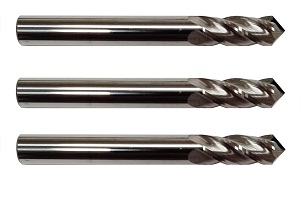After the adoption of milling machines in custom production operations, shops have never stopped discovering innovative and efficient ways to increase productivity and widen the range of operations they can perform with their tools. CNC-guided machines have also pushed this innovative process forward as they allow us to project more aggressive tool paths or program tools to cut in ways we never thought possible. They also give us superior control and accuracy, opening the door for faster feed rates and speeds.

Traditionally, operators have to use specific tools for specific tasks. This remains true in many situations as driving the wrong tool for your cut usually yields subpar results, or can cause major problems. Complex parts or projects typically require switching tools to perform specific cuts such as driving holes, precision cuttings, slotting, and finishing. Tool cycling can eat up a lot of production time and slow down production drastically. Many tool manufacturers have tried to come up with designs that help machinists reduce tool cycling.
There are few tools more versatile than drill mills. Drill mills combine the sharp cutting point of spot drills and drill bits, with the side milling found on end mills and finishing tools. Combining the traits of these heavily used tools, machinists can perform a wide variety of cuts and tasks on a piece without having to change tools.
For example, operations that need to drill holes and create slots can perform both operations in one plunge. Unlike traditional spot drills, drill mills can perform smooth and deep cuts and then transition to side milling provided you are using a sacrificial surface below your piece.
The tool can perform smooth V-shaped notches and valleys, and be used for engraving and slotting leaving perfectly finished walls and floors that need little to no post-milling. Additionally, drill mills can be used for finishing tasks. Solid carbide drill mills are especially appropriate for this as they retain their sharpness better than steel tools providing incredibly smooth finishes, even on hardened alloys.
Today, it is not uncommon to see shops using carbide drill mills to create smooth chamfers on pieces that have sharpened sides. Given the point geometry of drill mills, they can easily add a chamfer or intermediate angle between intersecting sides, providing a safe and handsome chamfer, even on internal edges. Beveling and engraving are also possible with drill mills.
To reduce tool cycling even more, make sure you use carbide drill mills. They are extremely hard and rigid, which increases accuracy and allows you to drive them at higher speeds for faster operation. They also have incredibly high-temperature resistance, which means that you don’t have to worry about running them too hot or slowing down your feed rates.
Carbide tools also last up to ten times longer than steel tools and retain their sharpness even under heavy loads and cuts. Their strength comes from the amazing properties of ceramic tungsten carbide. This composite is a lot stronger and denser than steel and, unlike metals, their strength and sharpness retention does not come from heat tempering, reducing the effects of heat on its physical composition. This means tool change becomes less of an issue and you can finish a lot more pieces with a single tool without having to replace it, which usually translates into more finished pieces per hour.
If you are looking into increasing productivity by having extremely versatile and durable tools, you should visit Online Carbide. This American manufacturer specializes in designing and crafting high-performance carbide tools such as drill mills and other cutting tools. Contact them today and learn more about their products and competitive prices.
For more information about Variable End Mill and Best End Mills For Aluminum Please visit: Online Carbide.
Hi, I am Adam Smith, Admin Of TechSketcher, Creative blogger and Digital Marketer.